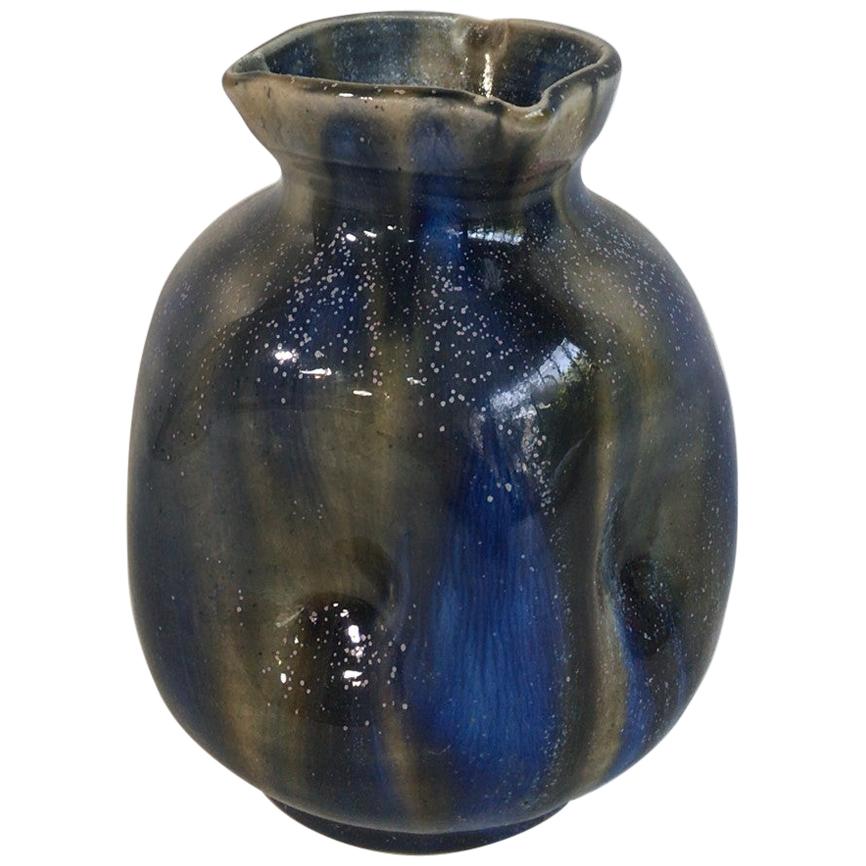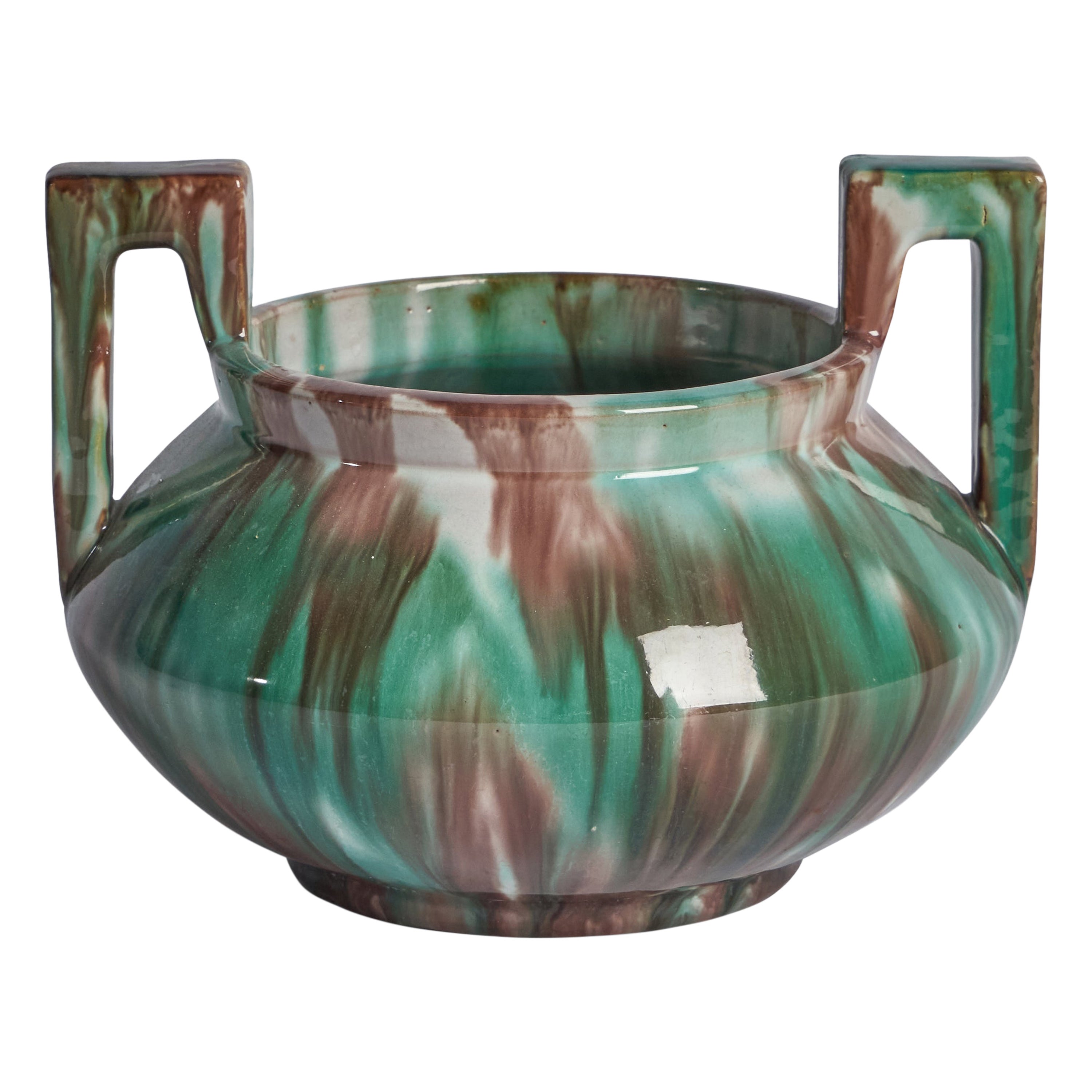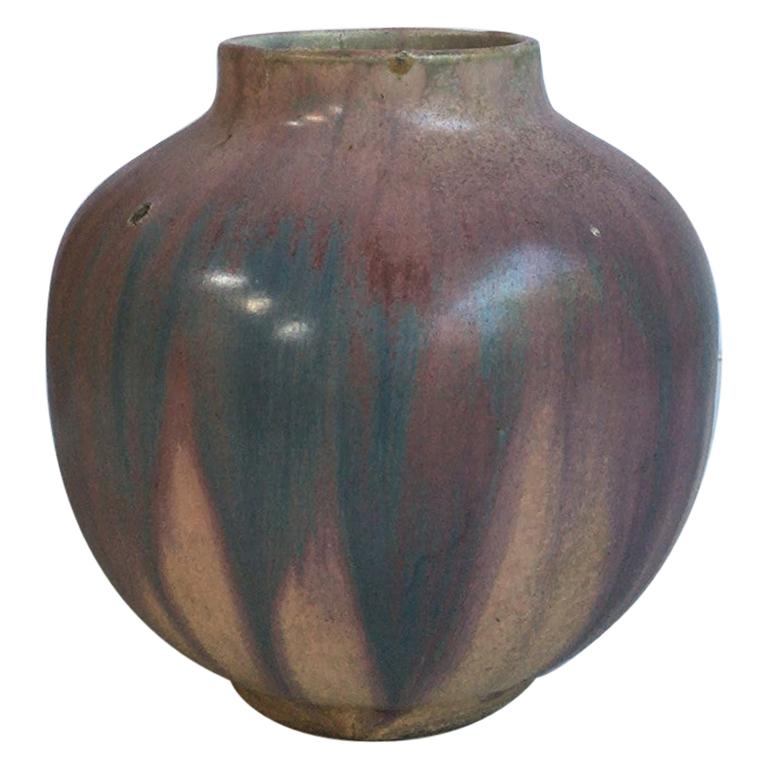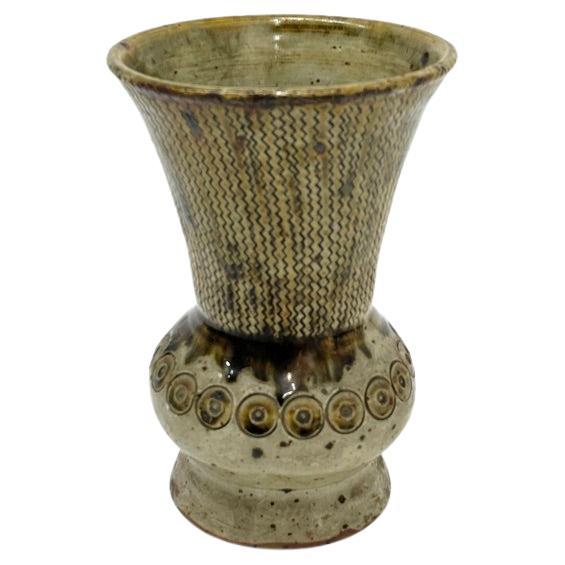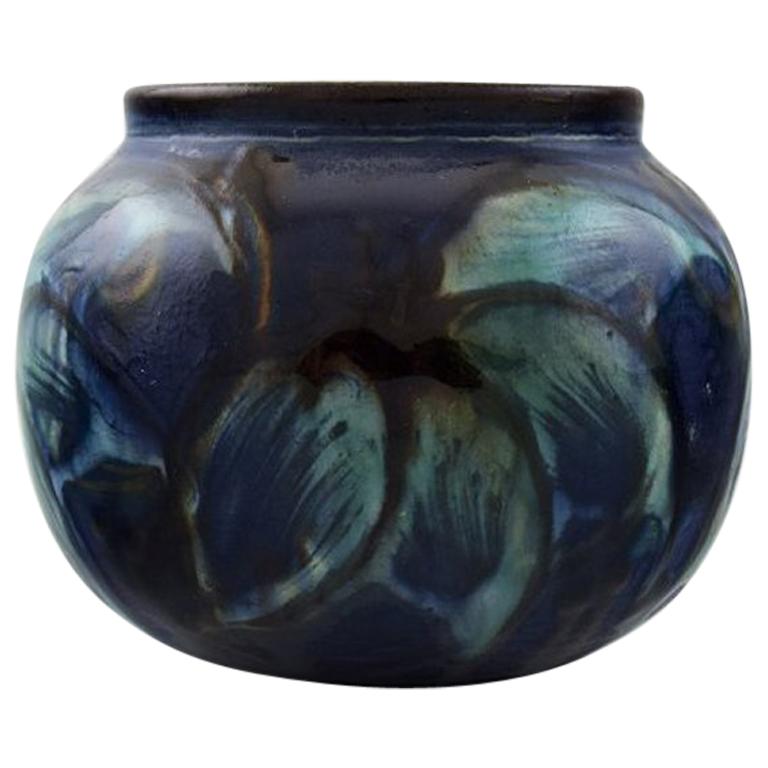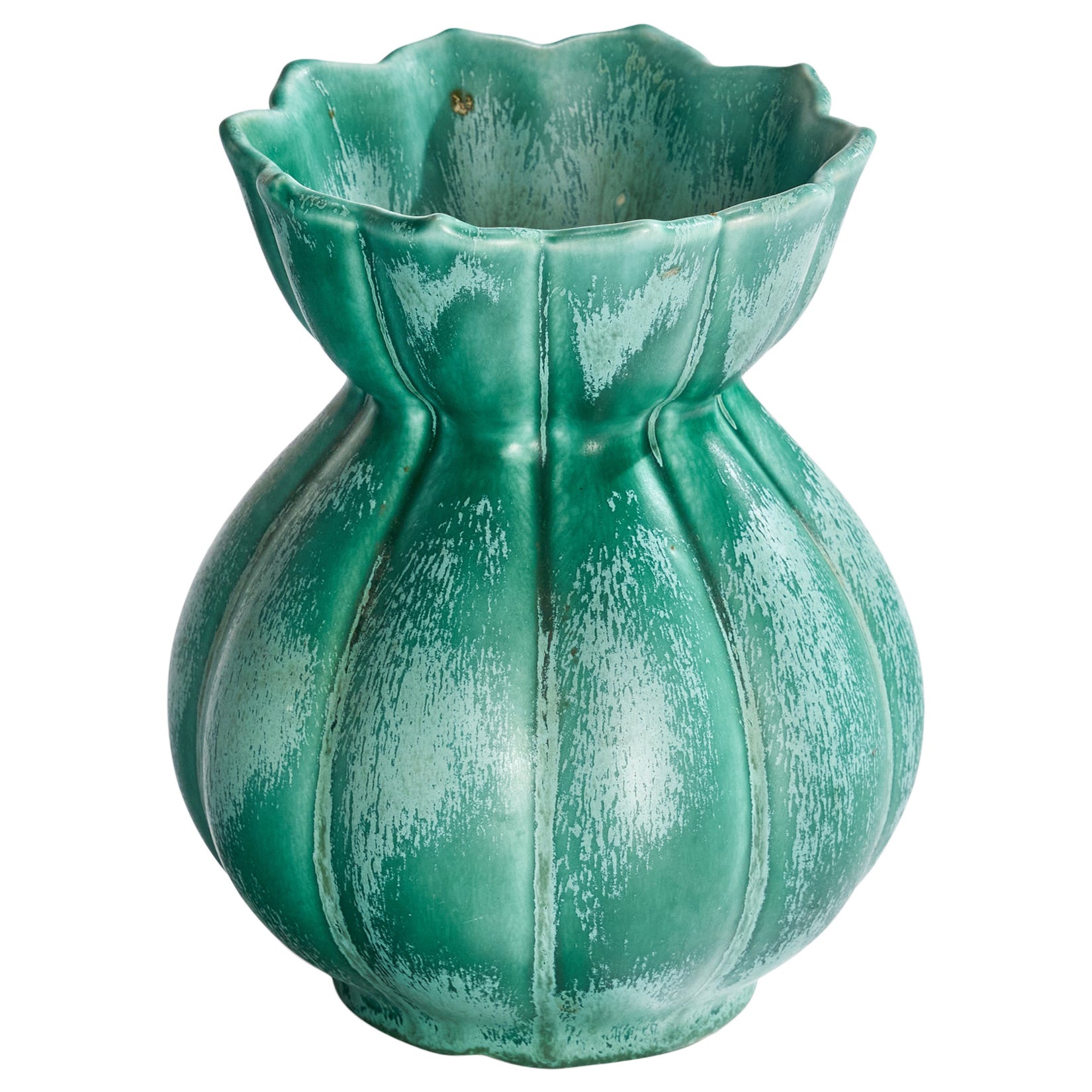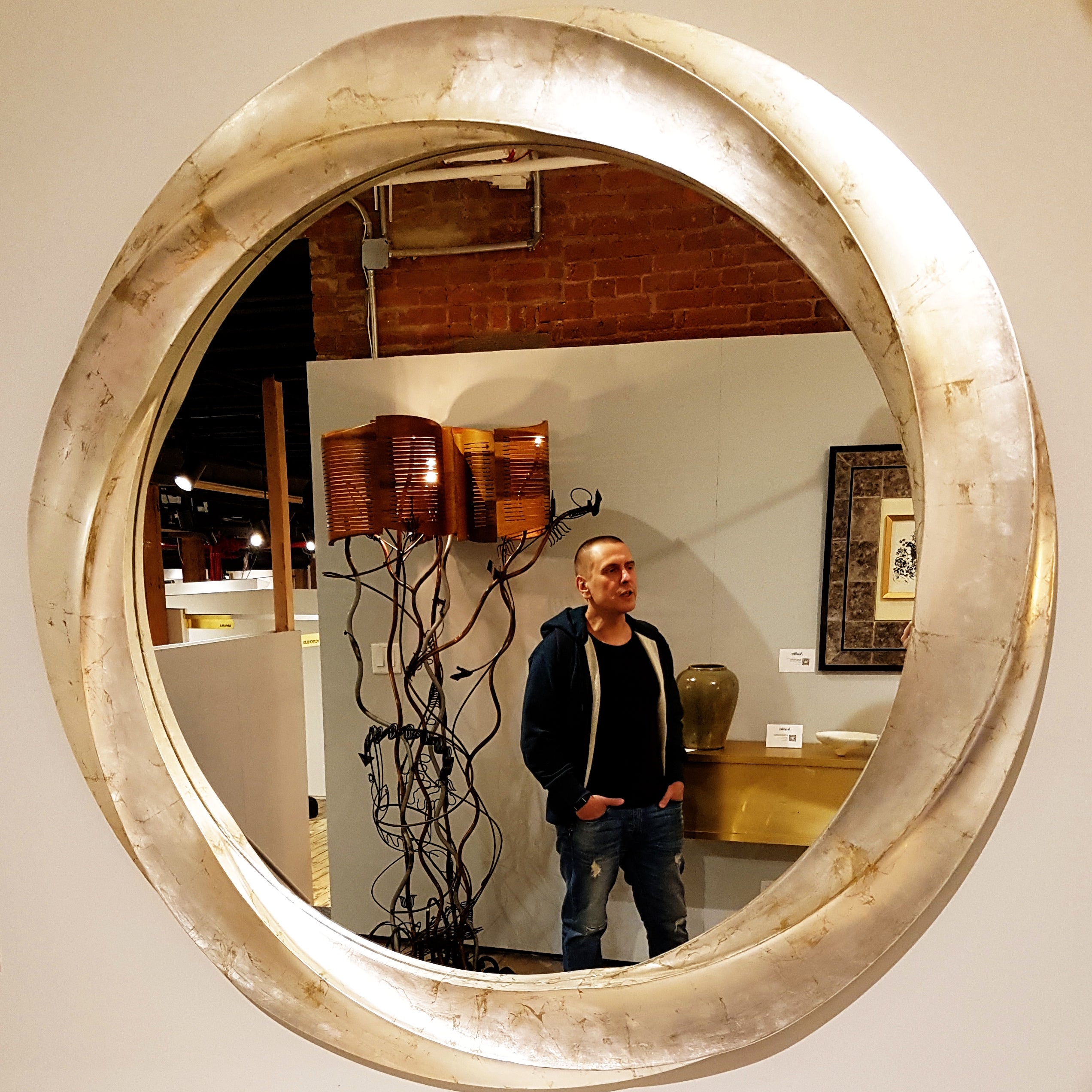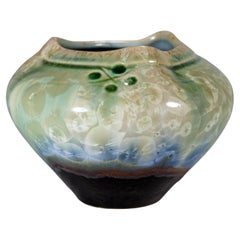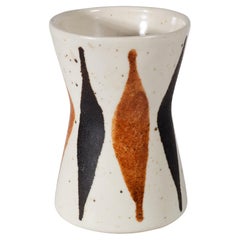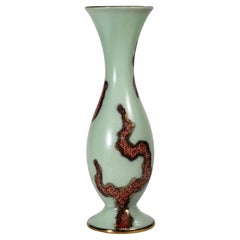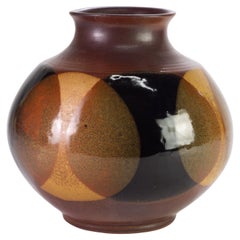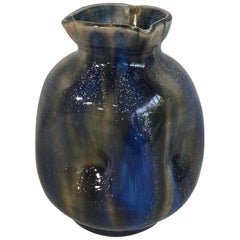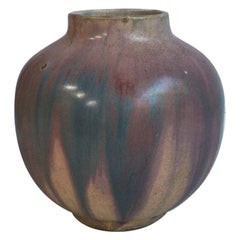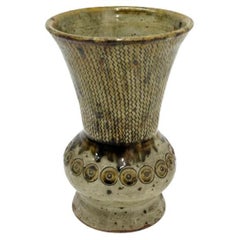Items Similar to Linn Phelan Vase, Early American Studio Pottery 1932
Video Loading
Want more images or videos?
Request additional images or videos from the seller
1 of 12
Linn Phelan Vase, Early American Studio Pottery 1932
$925
£702.43
€811.96
CA$1,300
A$1,447.55
CHF 765.50
MX$17,615.77
NOK 9,649.26
SEK 9,091.02
DKK 6,059.91
About the Item
Sculptural vintage vase features a bulbous body with pronounced wide rim; it is decorated in complex drip glaze in blue, teal, and green palette with beige pink accents. Parts of the vase near the bottom are intentionally left unglazed to accentuate the unpredictable nature of the drip glazes. The inner surfaces are decorated with the glazes in the same palette, and the inner part of the rim is done with the same drip glaze pattern as the outer surfaces, creating a continuous composition and guiding the eyes of the viewers along the lines of the piece.
The vase is signed and dated by the artist on the bottom, "Linn L. Phelan 1932", circling the base, and marked with that appears to be either model or glaze numbers in the center. The date corresponds with Phelan's training under Arthur Baggs; the vase is an important example of Phelan's early work and of early American studio pottery movement. While the form of the vase shows Art Deco style influence, the striking glaze on the piece points towards the distinctive works Phelan created later in his career. We are offering a large ceramic decorative bowl, created by Phelan in 1950s-1960s, in a separate listing.
Linn Lovejoy Phelan (1906-1992) was a renowned American ceramic artist, who operated famous Rowantrees and Linwood Pottery in Maine. He studied art in Bevier School of Art of the Rochester Athenaeum and Mechanics Institute (now Rochester Institute of Technology) in Rochester, New York, in 1928, and received his BFA in Ceramic Art in Ohio State University, Columbus, Ohio, in 1932. While attending Ohio State University, Phelan took "Ceramic Art: Survey of the Field" class, taught by Arthur Baggs. After Phelan left the school, he corresponded with Baggs, and in late 1930s Phelan wrote to Baggs of his experiences in helping to start up what becomes Rowantrees Pottery of Blue Hill, Maine. Arthur E. Baggs (1886-1947) studied at Alfred University in 1903-1905 and 1910-1911 with Dr. Charles F. Binns, who was considered "the father of American ceramic art"; Baggs worked at Marblehead Pottery and Cowan Pottery Studio, and became the head of the Ceramic Art Division of the Fine Arts Department at Ohio State University in 1928. Examples of Baggs work are in the collections of The Metropolitan Museum of Art in New York; Museum of Fine Arts, Boston; Everson Museum of Art in Syracuse, NY; and Columbus Museum of Art in Ohio. Baggs was an extremely influential figure in early American ceramics; he was given the Binns medal for outstanding achievement, made a Fellow of the American Ceramic Society and a member of Keramos. Through Baggs Phelan was exposed to the foundations of technical creativity and advancements in ceramic art in Alfred University, as well as the early 1900s studio pottery movement in America, linking the Arts and Crafts phase of studio pottery to Modernist movement.
In 1940s Phelan started teaching ceramics at School of American Craftsman (SAC), founded by Aileen Osborn Webb at Darthmouth College in 1944; SAC moved to Alfred University in Alfred, New York, in 1946, and to Rochester Institute of Technology (RIT) in 1950s. In 1940s SAC faculty included Edwin Blanchard Brown, Ernest Frank Brace, Laurits Eichner, Philip Morton, Charles Reese, Ethel Mitchell, Robert Savage, Thomas Mclure, along with Linn Phelan and another renowned ceramist, Herbert Sanders; in early 1950s new additions to the SAC faculty included Copenhagen-trained woodworker Tage Frid and metalworker John Prip, Danish silversmith Hans Christensen, as well as Olin Russum, Vienna-educated member of Austrian "Werkbund" Mitzi Otten, design teacher Fred Meyer, and Bauhaus-trained ceramist Frans Wildenhain; sculptor and woodworker Wendell Castle joined SAC faculty in early 1960s. Through his experiences with SAC Phelan participated in guiding and supporting a new generation of American artists, designers, and craftsman; many SAC students went on to achieve national reputation.
In 1950s, in years after SAC moved to Rochester, Phelan made a decision to return to Allegany County, where he bought a house while teaching at Alfred University, to continue his independent studio work. Phelan reestablished Linwood Pottery in Almond, NY, and continued to operate it for the rest of his life. He was involved in teaching art at Alfred-Almond Central School in Almond, NY, in 1950s-1960s, contributed to cultural initiatives in Maine and New York, and served as president of the New York State Art Teachers Association. Phelan's work can be found in both public and private collections nationwide.
- Creator:Linn Lovejoy Phelan (Artist)
- Dimensions:Height: 4.55 in (11.56 cm)Diameter: 4.5 in (11.43 cm)
- Materials and Techniques:
- Place of Origin:
- Period:
- Date of Manufacture:1932
- Condition:Wear consistent with age and use.
- Seller Location:Clifton Springs, NY
- Reference Number:1stDibs: LU4421146212292
Roman Erlikh
Roman Erlikh is a professional woodworker with over 20 years’ experience. Roman Erlikh Studio creates bespoke and limited edition contemporary furniture and art objects. His first furniture collections were inspired by traditional Art Deco and Biedermeier styles interpreted through a modern lifestyle demands. Stepping away from merely utilitarian view of everyday objects, his recent collections are filled with meaningful textual context while incorporating traditional and modern woodworking techniques. Roman is using practical function as a common denominator to create emotionally charged art objects, blurring the boundary between art and function. While appreciating possibilities of ordinary materials, Roman is developing new mixed media multilayered composite varnishes and utilizes decorative gilding and mica veneer to actively engage ambient light, giving an additional aspect to relation of his objects to their environment. The decision to work in custom format was based on environmental concerns and opposition to culture of mass production and pure consumerism. The choice of materials was heavily influenced by sustainability and environmental concerns. All objects are made locally in the Brooklyn Navy Yard workshop. Elimination of storage and transportation needs for mass-produced furniture in lieu of creating a custom made objects on demand allows us to reduce waste of materials and energy.
About the Seller
5.0
Platinum Seller
Premium sellers with a 4.7+ rating and 24-hour response times
Established in 2011
1stDibs seller since 2019
201 sales on 1stDibs
Typical response time: <1 hour
- ShippingRetrieving quote...Shipping from: Clifton Springs, NY
- Return Policy
Authenticity Guarantee
In the unlikely event there’s an issue with an item’s authenticity, contact us within 1 year for a full refund. DetailsMoney-Back Guarantee
If your item is not as described, is damaged in transit, or does not arrive, contact us within 7 days for a full refund. Details24-Hour Cancellation
You have a 24-hour grace period in which to reconsider your purchase, with no questions asked.Vetted Professional Sellers
Our world-class sellers must adhere to strict standards for service and quality, maintaining the integrity of our listings.Price-Match Guarantee
If you find that a seller listed the same item for a lower price elsewhere, we’ll match it.Trusted Global Delivery
Our best-in-class carrier network provides specialized shipping options worldwide, including custom delivery.More From This Seller
View AllKent Follette Crystalline Vase, American Studio Art Pottery
Located in Clifton Springs, NY
Striking studio pottery vase features crystalline glaze in bright, but harmonious teal, grey, and beige tones on the top part of the vase and burnt orange and espresso brown drip gl...
Category
Late 20th Century American Organic Modern Vases
Materials
Ceramic, Pottery
Frank Mann Modernist Vase, Early American Studio Pottery 1950s-1960s
By Frank Mann
Located in Clifton Springs, NY
Mid Century Modern ceramic vase features abstract graphic design in alternating brown and black shapes on mottled off-white background. The bold, but organic decor complements the h...
Category
Mid-20th Century American Mid-Century Modern Vases
Materials
Ceramic, Stoneware, Pottery
Jasba Vase, West German Pottery 1950s-1960s
By Jasba
Located in Clifton Springs, NY
Mid Century Modern ceramic vase features an abstract motif in Burgundy red glaze, sponged on in free-flowing patterns and outlined with gold, on light green background. The decor ap...
Category
Mid-20th Century German Mid-Century Modern Vases
Materials
Ceramic, Majolica, Pottery
Robert Maxwell for Pottery Craft USA Vase
By Robert Maxwell
Located in Clifton Springs, NY
Striking modern slip-cast vase with overlapping circles motif was created by Robert Maxwell for Pottery Craft USA using his innovative glazing techn...
Category
20th Century American Mid-Century Modern Vases
Materials
Pottery
Lee Levy Multi Spouted Vase, American Studio Pottery
Located in Clifton Springs, NY
Vintage ceramic bud vase features sculptural multi spouted shape and stunning textured drip glaze in earthy, organic brown palette. The gradation glaze color and abstract graphic pattern of the main decor emphasize the soft, rounded shape of the vase; the use of shades of brown, from dark espresso to mocha to off-shite cappuccino, creates rich and varied, but monochromatic palette that does not overpower the complex form and shape of the vase.
The vase is signed on the bottom with LEE, that was Lee Levy customary signature; it is not dated, but the style of the piece is consistent with her Mid-Century Modern pieces created in 1960s-1970s.
Leah "Lee" Levy (1922 - 2011) was an established pottery artist based in Upstate New York area. She was born in Pinsk, formerly in Poland, now in Belarus, and moved to the United States in 1929, growing up in Brookline, Massachusetts. She and her husband Irving started their first pottery studio in Long Island, New York, in late 1940s, while training at the Alfred University School of Ceramics alongside with some of the foremost artists and craftsman in America. Since 1946, Alfred University in Alfred, New York was a home for School for American Craftsmen, with the faculty that included Edwin Blanchard Brown, Ernest Frank Brace, Laurits Eichner, Philip Morton, Charles Reese, Ethel Mitchell, Robert Savage, Thomas Mclure, and most importantly for Levy, the renowned ceramists Linn Phelan and Herbert Sanders...
Category
Mid-20th Century American Organic Modern Vases
Materials
Ceramic, Pottery, Stoneware
Robert Maxwell for Pottery Craft USA Bud Vase
By Robert Maxwell
Located in Clifton Springs, NY
Striking modern slip-cast vase with overlapping circles motif was created by Robert Maxwell for Pottery Craft USA using his innovative glazing techn...
Category
Mid-20th Century Mid-Century Modern Vases
Materials
Pottery
You May Also Like
Art Deco Pottery Vase Charles Greber, circa 1930
By Charles Greber
Located in Austin, TX
Art Deco pottery vase Charles Greber, circa 1930.
Category
Vintage 1930s French Art Deco Vases
Materials
Pottery
Gustaf Ahlberg, Vase, Earthenware, Sweden, 1920s
Located in High Point, NC
A green and brown-glazed earthenware vase designed and produced by Gustaf Ahlberg, Höganäs, Sweden, c. 1920s.
Category
Vintage 1920s Swedish Scandinavian Modern Vases
Materials
Earthenware
Art Deco Pottery Vase Charles Greber, circa 1930
By Charles Greber
Located in Austin, TX
Art Deco pottery vase Charles Greber, circa 1930.
Category
Vintage 1930s French Art Deco Vases
Materials
Pottery
Vase by Lucien Talbot, La Borne, 1940
By La Borne Potters
Located in PARIS, FR
Vase by Lucien Talbot, La Borne, 1940
Cuisson au bois
Parfait état d'origine
Category
Vintage 1940s French Vases
Materials
Sandstone
Kähler, Denmark, Glazed Stoneware Vase in Modern Design, 1930s-1940s
Located in København, Copenhagen
Kähler, Denmark, glazed stoneware vase in modern design,
1930s-1940s. Cow Horn technique.
Stamped.
Measures: 9.5 x 7.5 cm.
In perfect condition.
Category
Vintage 1930s Danish Art Deco Vases
Materials
Stoneware
Ewald Dahlskog, Vase, Ceramic, Sweden, 1930s
By Arthur Percy
Located in High Point, NC
A green-glazed ceramic vase designed by Ewald Dahlskog and produced by Bo Fajans, Sweden, c. 1930s.
Dimensions: 6.25” H x 5.25” diameter
Diameter of opening: 1.875”
Category
Vintage 1930s Swedish Scandinavian Modern Vases
Materials
Ceramic
More Ways To Browse
Blenko Bamboo Vase
Blyberg Porphyry
Florian Ware
Guaxs Glass Vase
Rookwood Rook
Signoretti Glass
Val St Lambert Purple Cut Glass Vase
Friedegart Glatzle
Gador Istvan
Hank Keramikk
J Johnston Brass
Ardmore Ceramic Vase
Per Liljegren
Rosamunde Nairac
Royal Copenhagen Crystal Vase
Vallenti Vase
Vic Bracke
Viking Glass By New Martinsville
